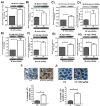Antitumor activities of Quercetin and Green Tea in xenografts of human leukemia HL60 cells
- PMID: 29472583
- PMCID: PMC5823936
- DOI: 10.1038/s41598-018-21516-5
Antitumor activities of Quercetin and Green Tea in xenografts of human leukemia HL60 cells
Abstract
Quercetin is one of the most abundant flavonoids, present in fruits and vegetables and has been shown to have multiple properties capable of reducing cell growth in cancer cells. Green tea is a widely consumed beverage, known for a potential source of free radical scavenging and anti-cancer activities. Herein, we investigate the in vivo antitumor efficacy of quercetin and green tea in human leukemia. Human tumors were xenografted into NOD/SCID mice. Quercetin and green tea reduced tumor growth in HL-60 xenografts accompanied by decreased expression of anti-apoptotic proteins, BCL-2, BCL-XL and MCL-1 and increased expression of BAX, a pro-apoptotic protein. Moreover, caspase-3 was activated to a greater extent after quercetin and green tea treatment. Quercetin and green tea also mediated G1 phase cell cycle arrest in HL-60 xenografts. Treatment with quercetin and green tea induced conversion of LC3-I to LC3-II as well as activation of autophagy proteins, suggesting that quercetin and green tea initiate the autophagic progression. We have provided evidence that quercetin and green tea induces signaling at the level of apoptosis, cell cycle and autophagy which converge to antigrowth effects in HL-60 xenograft mice suggesting that these compounds may be a compelling ally in cancer treatment.
Conflict of interest statement
The authors declare no competing interests.
Figures




Similar articles
-
Quercetin simultaneously induces G0 /G1 -phase arrest and caspase-mediated crosstalk between apoptosis and autophagy in human leukemia HL-60 cells.Environ Toxicol. 2017 Jul;32(7):1857-1868. doi: 10.1002/tox.22408. Epub 2017 Mar 2. Environ Toxicol. 2017. PMID: 28251795
-
Multitarget effects of quercetin in leukemia.Cancer Prev Res (Phila). 2014 Dec;7(12):1240-50. doi: 10.1158/1940-6207.CAPR-13-0383. Epub 2014 Oct 7. Cancer Prev Res (Phila). 2014. PMID: 25293876
-
Quercetin induces tumor-selective apoptosis through downregulation of Mcl-1 and activation of Bax.Clin Cancer Res. 2010 Dec 1;16(23):5679-91. doi: 10.1158/1078-0432.CCR-10-1565. Clin Cancer Res. 2010. PMID: 21138867 Free PMC article.
-
Apoptotic Mechanisms of Quercetin in Liver Cancer: Recent Trends and Advancements.Pharmaceutics. 2023 Feb 20;15(2):712. doi: 10.3390/pharmaceutics15020712. Pharmaceutics. 2023. PMID: 36840034 Free PMC article. Review.
-
Role of Ginseng, Quercetin, and Tea in Enhancing Chemotherapeutic Efficacy of Colorectal Cancer.Front Med (Lausanne). 2022 Jun 20;9:939424. doi: 10.3389/fmed.2022.939424. eCollection 2022. Front Med (Lausanne). 2022. PMID: 35795631 Free PMC article. Review.
Cited by
-
Immunomodulatory Effect of Green Tea Treatment in Combination with Low-dose Chemotherapy in Elderly Acute Myeloid Leukemia Patients with Myelodysplasia-related Changes.Integr Cancer Ther. 2021 Jan-Dec;20:15347354211002647. doi: 10.1177/15347354211002647. Integr Cancer Ther. 2021. PMID: 33754891 Free PMC article.
-
The Neuroprotective Effect of Tea Polyphenols on the Regulation of Intestinal Flora.Molecules. 2021 Jun 17;26(12):3692. doi: 10.3390/molecules26123692. Molecules. 2021. PMID: 34204244 Free PMC article. Review.
-
Quercetin Covalently Linked Lipid Nanoparticles: Multifaceted Killing Effect on Tumor Cells.ACS Omega. 2020 Nov 10;5(46):30274-30281. doi: 10.1021/acsomega.0c04795. eCollection 2020 Nov 24. ACS Omega. 2020. PMID: 33251462 Free PMC article.
-
Quercetin Induces Apoptosis via Downregulation of Vascular Endothelial Growth Factor/Akt Signaling Pathway in Acute Myeloid Leukemia Cells.Front Pharmacol. 2020 Dec 10;11:534171. doi: 10.3389/fphar.2020.534171. eCollection 2020. Front Pharmacol. 2020. PMID: 33362534 Free PMC article.
-
Autophagy: Mechanisms and Therapeutic Potential of Flavonoids in Cancer.Biomolecules. 2021 Jan 21;11(2):135. doi: 10.3390/biom11020135. Biomolecules. 2021. PMID: 33494431 Free PMC article. Review.
References
-
- Chabner, B. A. In: Goodman & Gilman’s The Pharmacological Basis of Therapeutics. 11th Edition. Brunton LL, Lazo JS, Parker KL, editors New York: 1257–1262 (McGraw-Hill 2006).
-
- Guérritte F. In: Anticancer Agents from Natural Products. Cragg GM, Kingston DGI, Newman DJ, editors Boca Raton, FL: 123–135 (CRC/Taylor & Francis 2005).
-
- Lee K. H. In: Anticancer Agents from Natural Products. Cragg GM, Kingston DGI, Newman DJ, editors. Boca Raton, FL: 71–87 (CRC/Taylor & Francis 2005).
Publication types
MeSH terms
Substances
LinkOut - more resources
Full Text Sources
Other Literature Sources
Medical
Research Materials

